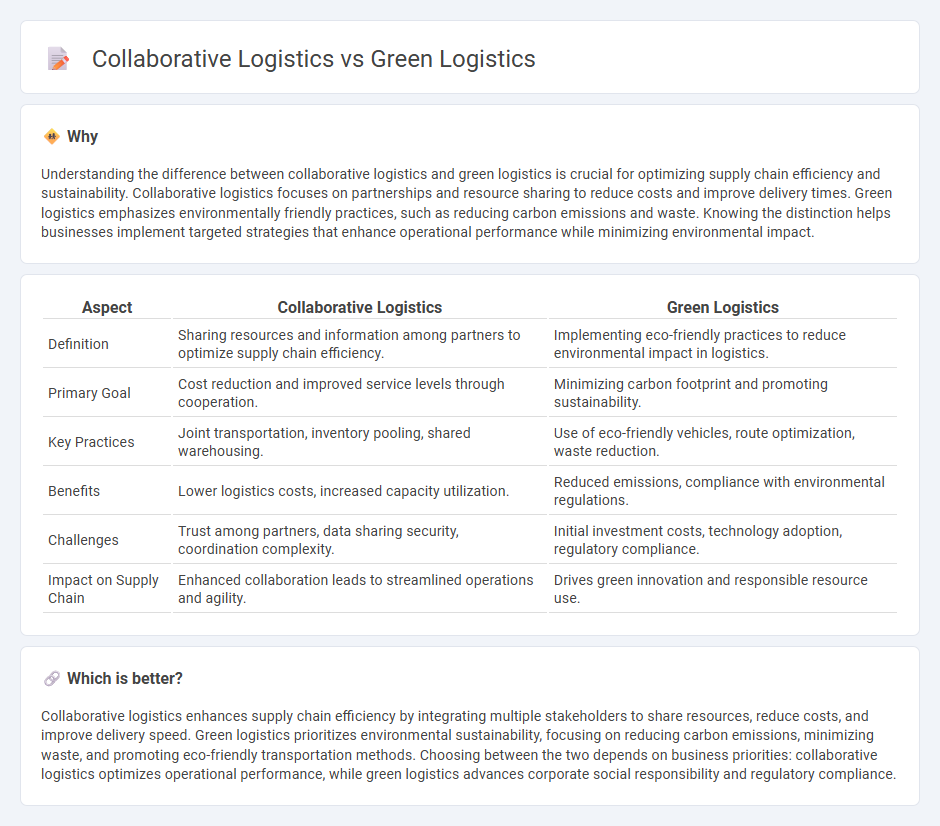
Collaborative logistics integrates multiple stakeholders to optimize transportation and inventory management, reducing costs and enhancing supply chain efficiency. Green logistics focuses on minimizing environmental impact through sustainable practices such as carbon footprint reduction and eco-friendly packaging. Explore how combining collaborative and green logistics strategies can revolutionize supply chain sustainability and performance.
Why it is important
Understanding the difference between collaborative logistics and green logistics is crucial for optimizing supply chain efficiency and sustainability. Collaborative logistics focuses on partnerships and resource sharing to reduce costs and improve delivery times. Green logistics emphasizes environmentally friendly practices, such as reducing carbon emissions and waste. Knowing the distinction helps businesses implement targeted strategies that enhance operational performance while minimizing environmental impact.
Comparison Table
| Aspect | Collaborative Logistics | Green Logistics |
|---|---|---|
| Definition | Sharing resources and information among partners to optimize supply chain efficiency. | Implementing eco-friendly practices to reduce environmental impact in logistics. |
| Primary Goal | Cost reduction and improved service levels through cooperation. | Minimizing carbon footprint and promoting sustainability. |
| Key Practices | Joint transportation, inventory pooling, shared warehousing. | Use of eco-friendly vehicles, route optimization, waste reduction. |
| Benefits | Lower logistics costs, increased capacity utilization. | Reduced emissions, compliance with environmental regulations. |
| Challenges | Trust among partners, data sharing security, coordination complexity. | Initial investment costs, technology adoption, regulatory compliance. |
| Impact on Supply Chain | Enhanced collaboration leads to streamlined operations and agility. | Drives green innovation and responsible resource use. |
Which is better?
Collaborative logistics enhances supply chain efficiency by integrating multiple stakeholders to share resources, reduce costs, and improve delivery speed. Green logistics prioritizes environmental sustainability, focusing on reducing carbon emissions, minimizing waste, and promoting eco-friendly transportation methods. Choosing between the two depends on business priorities: collaborative logistics optimizes operational performance, while green logistics advances corporate social responsibility and regulatory compliance.
Connection
Collaborative logistics enhances green logistics by optimizing resource sharing, reducing redundant transportation, and lowering carbon emissions through coordinated efforts among multiple stakeholders. Integrating real-time data and efficient route planning in collaborative logistics directly supports sustainability goals by minimizing fuel consumption and waste. This synergy accelerates the transition to eco-friendly supply chains, promoting environmental responsibility while maintaining operational efficiency.
Key Terms
**Green Logistics:**
Green logistics emphasizes reducing the environmental impact of supply chain operations through energy-efficient transportation, sustainable packaging, and minimizing carbon emissions. It integrates renewable energy sources and eco-friendly practices across warehousing, distribution, and last-mile delivery to promote sustainability. Explore innovative green logistics strategies to enhance your eco-conscious supply chain management.
Carbon footprint
Green logistics emphasizes reducing the carbon footprint through sustainable practices such as energy-efficient transportation, renewable energy use, and waste minimization. Collaborative logistics involves multiple stakeholders sharing resources and information to optimize routes and loads, significantly lowering emissions by reducing fuel consumption and improving supply chain efficiency. Explore how these strategies can synergize for a comprehensive approach to minimizing carbon footprints in logistics.
Sustainable transportation
Green logistics emphasizes reducing environmental impact through energy-efficient transportation modes, alternative fuels, and minimized carbon emissions. Collaborative logistics enhances sustainability by sharing resources, such as vehicles and warehouses, among multiple partners to optimize routing and reduce fuel consumption. Explore more to understand how integrating these approaches can drive sustainable transportation goals effectively.
Source and External Links
What Is Green Logistics? Overview, Benefits, and Strategies - Shopify - Green logistics involves optimizing transportation, storage, and distribution to minimize environmental impact through strategies like route planning, load pooling, sustainable packaging, and eco-conscious partnerships.
What is Low-Emission Logistics & What are Its Benefits? | DHL Global - Low-emission logistics reduces emissions and waste by using alternative fuels, electric vehicles, energy-efficient warehouses, sustainable packaging, and transport cost-saving practices like route optimization and load consolidation.
Green logistics: advantages and how to apply it | AR Racking Inc - Green logistics considers environmental footprint across the entire supply chain by optimizing warehouse storage, reducing handling, lowering pollution and energy use, and improving overall operational efficiency.
 dowidth.com
dowidth.com